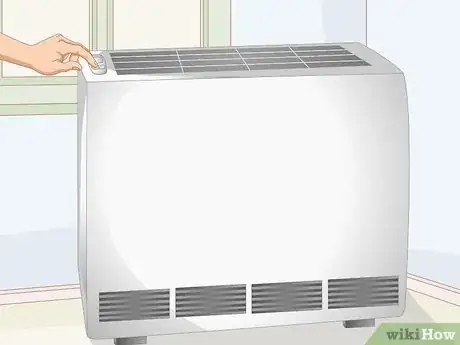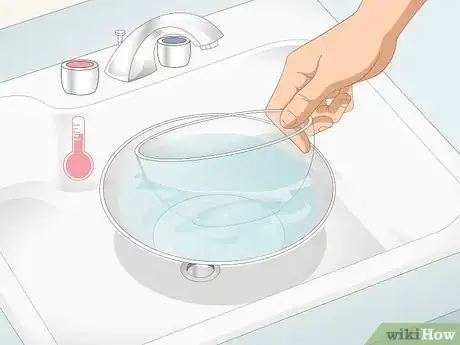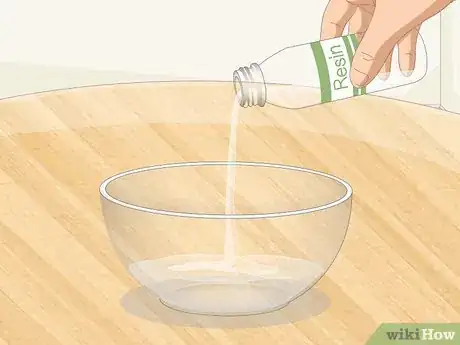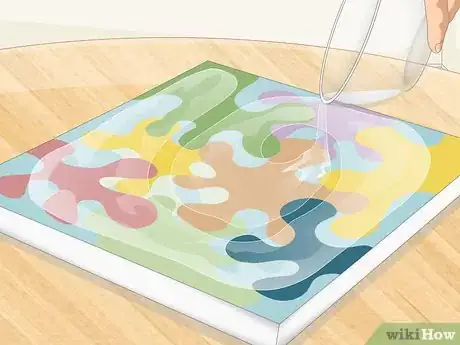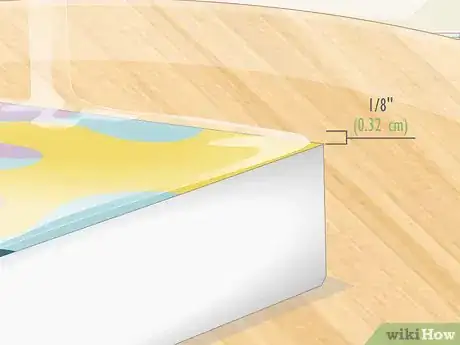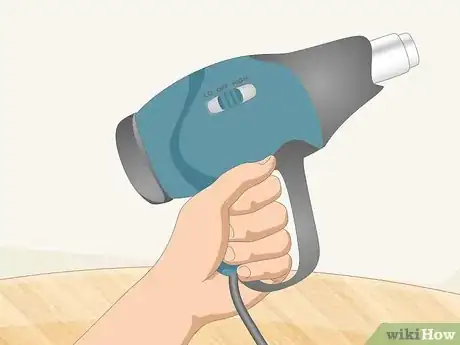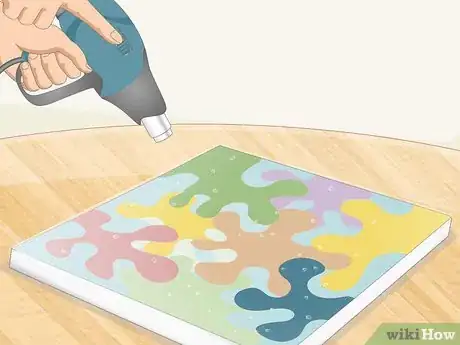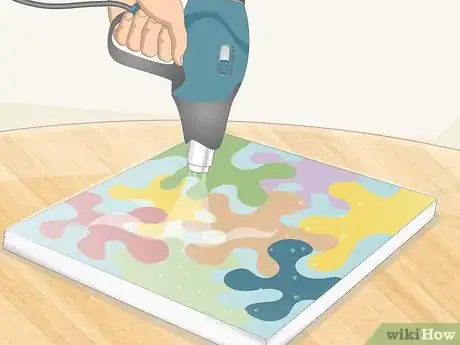This article was co-authored by wikiHow staff writer, Eric McClure. Eric McClure is an editing fellow at wikiHow where he has been editing, researching, and creating content since 2019. A former educator and poet, his work has appeared in Carcinogenic Poetry, Shot Glass Journal, Prairie Margins, and The Rusty Nail. His digital chapbook, The Internet, was also published in TL;DR Magazine. He was the winner of the Paul Carroll award for outstanding achievement in creative writing in 2014, and he was a featured reader at the Poetry Foundation’s Open Door Reading Series in 2015. Eric holds a BA in English from the University of Illinois at Chicago, and an MEd in secondary education from DePaul University.
There are 8 references cited in this article, which can be found at the bottom of the page.
This article has been viewed 29,258 times.
Learn more...
Bubbles in resin are a common problem, but don't worry—you aren't stuck with them. In this article, we'll explain how to mix and pour resin so you can prevent bubbles from forming in the first place. We'll also cover several options for removing bubbles from hardened resin without damaging your finished project. If you're ready to master the art of bubble-free resin casting, read on!
Steps
Stirring and Warming the Resin
-
1Turn the heat on if you’re working indoors. Resin is a thick liquid that easily traps bubbles when it’s exposed to air. To encourage the bubbles to rise, you’ll use a combination of heat, slow mixing, and careful pouring. To help all of your materials warm up, turn the heat on if you’re working indoors. It doesn’t need to be burning up, but raising the temperature to 74–78 °F (23–26 °C) can really promote the bubbles to rise out of the resin.[1]
- Air bubbles in resin are just trapped pockets of air. Hot air rises. If you can heat the bubbles, they’ll naturally lift out on their own.
-
2Soak your resin bottles in warm water to lift the bubbles out. Get a small bowl or tray that will hold your bottles of resin. Turn the tap water in your sink to the hottest temperature. After your water warms up, fill the container with warm water. Set it down and place your bottles in the water. Let the resin soak for 10-15 minutes to warm the containers up.[2]
- If you’re using resin with a dye in it, use lukewarm water instead. For some brands of dyed resin, hot water can cause the pigment and resin to separate.
Advertisement -
3Warm your pouring cup before pouring your resin in. Most people mix and pour resin out of a dedicated glass container with a spout to make the process easier. If you aren’t pouring your resin directly out of the bottle, take your pouring cup and set it in a tray or bowl of warm water the same way that you soaked your resin. Let it soak for 10-15 minutes to heat it up.[3]
- Do not fill the inside of the cup with water to avoid contaminating your resin.
Tip: It is highly recommended that you use a wide-mouthed cup or beaker to pour resin. You can’t mix resin in the container that it came in, and mixing the resin ensures that it creates an even, uniform texture. Most resins need to be mixed anyway to be activated.
-
4Add your resin to the pouring cup slowly. Once your bottles and cups have all warmed up, take your resin container and remove the cap. Slowly pour your resin into the cup by tilting it at a 45-degree angle 2–4 inches (5.1–10.2 cm) away from the bottom of the cup. Squeeze your resin out in a circular pattern around the bottom of the cup.[4]
- Pouring the resin slowly ensures that it doesn’t catch any air underneath it as it fills the pouring cup.
- Move the resin container up as your cup fills up.
-
5Stir the mixture slowly for 5 minutes to bring bubbles to the top. Take your mixing stick or spoon and insert it into the resin. Press the stick or spoon against the bottom of the cup and slowly stir the resin, completing each rotation around the cup after 5-6 seconds. Stir the resin slowly for 5-10 minutes to bring most of the bubbles to the top.[5]
- For maximum efficiency, stir the resin while the mixing cup is sitting in warm water. Be careful to avoid spilling water into the cup, though.
-
6Let the resin sit for 3 minutes to give the bubbles time to rise. Once you’ve stirred the resin, let it rest. Letting your resin rest for a few minutes gives the warmed bubbles time to rise to the top. After 3 minutes, take your pouring cup to the area where you’re applying your resin.[6]
- Mixing, heating, and letting your resin rest should all work to remove a vast majority of the bubbles in your resin.
Pouring the Resin
-
1Pour your resin slowly, 2–4 in (5.1–10.2 cm) from the surface. Start by pouring your resin in the middle of the cast or material that you’re covering. Hold the spout 2–4 in (5.1–10.2 cm) from the surface so that it fills evenly from the center.[7]
- For irregularly-shaped molds, move the cup back and forth across the mold carefully.
Tip: If you have 1 fluid ounce (30 mL) of resin, it should take you roughly 30-45 seconds to pour the resin out. The more methodical you are, the fewer bubbles you’ll trap.
-
2Pour the resin using a smooth, slow, circular motion. To avoid pouring the resin on top of itself, move the resin container around in a 3–4 in (7.6–10.2 cm) pattern as you pour. Move in the same direction, either clockwise or counterclockwise, to keep the resin from pouring on to the other sections you’ve just poured. This will keep air bubbles from getting caught in the resin as it pours on to your surface.[8]
- For irregularly-shaped molds, move the cup in an oval pattern as you move back and forth across the middle of the mold.
-
3Work in thin 1⁄8 in (0.32 cm) layers to avoid over-pouring. Once you’ve poured a thin layer that covers your entire surface, move the next step and use your heat gun or torch. After you’ve removed all of the bubbles from your first layer, pour your additional layers and repeat the process.[9]
- Working in separate layers avoids burying bubbles in the bottom of the resin. It takes resin 2-3 hours to dry anyway, so you don’t need to worry about the resin setting.
Heating the Bubbles out
-
1Get a butane torch or heat gun to remove your bubbles. To remove bubbles from resin that you’ve already poured, use a heat gun or butane torch. A heat gun is safer to use since it can’t accidentally start a fire, but a butane torch affords more freedom and accuracy when removing bubbles.[10]
- Do not use a hair dryer. The forceful air will cause the resin to splash and split. You’ll end up with an uneven finish and ruin whatever surface you’re working on.
- Read a bottle of resin carefully to determine whether or not the material is flammable. Most resins that are marketed for DIY crafts are non-flammable.
Warning: Some resins are flammable, and will catch fire if you touch them with a butane flame. However, it’s perfectly fine to use them so long as you keep the flame from making direct contact with the resin. Keep a fire extinguisher nearby in case any fires occur and always pour resin without any flammable materials nearby.
-
2Hold the torch or gun away from the surface and turn it on. With your gun or torch pointing away from the resin, turn it on by flipping the power switch on your heat gun or unlocking the safety on your torch. Turn the torch or gun on to the lowest power setting and pull the trigger to start the flame or heat. Give it 3-4 seconds to reach the desired temperature.
- The safety switch for a butane torch is usually a slide on the side of the torch, or underneath the nozzle. Some torches require you to hold a safety down while pulling the trigger to create the flame.
-
3Work the torch back and forth to lift the bubbles out. Hold the gun or torch 6–12 in (15–30 cm) away from the surface of your bubbles. Move the torch or gun back-and-forth in a 3–4 in (7.6–10.2 cm) section for 10-15 seconds. Usually, the bubble will pop at the surface after 3-4 seconds of heat, but some deeper bubbles will require more heat to lift them out.
- Some bubbles simply aren’t going to come out. Don’t heat the resin for so long that you’re going to change the consistency. If you need to heat an area for more than 30 seconds, you may be stuck with the bubble.
-
4Repeat this process for all of the bubbles in your resin. Use the heat gun or torch to lift out every other bubble in this layer of your resin. When you’ve removed the bubbles, continue pouring your next layer of resin. Use the same process to heat any bubbles out of your additional layers.[11]
Things You’ll Need
- Bowl or tray
- Warm water
- Pouring cup
- Spoon or mixing stick
- Heat gun or butane torch
References
- ↑ https://system.eu2.netsuite.com/core/media/media.nl?id=156593&c=3937524&h=7d958e9859c93a6bd624&_xt=.pdf
- ↑ https://youtu.be/zX4cz1BbqeY?t=27
- ↑ http://www.norski.co.nz/assets/Kleer_Kast_PG_2016.pdf
- ↑ http://www.norski.co.nz/assets/Kleer_Kast_PG_2016.pdf
- ↑ https://youtu.be/zX4cz1BbqeY?t=33
- ↑ http://www.norski.co.nz/assets/Kleer_Kast_PG_2016.pdf
- ↑ https://youtu.be/zX4cz1BbqeY?t=38
- ↑ https://youtu.be/zX4cz1BbqeY?t=38
- ↑ https://youtu.be/zX4cz1BbqeY?t=40
